Training for better balance is essential no matter what age you are. Whether young or old, good body balance reflects good balanced muscle development. It reduces the risk of injury, improves athletic performance, and maintains better functional movement for a lifetime. Balance is everything. Luckily, you can start from anywhere, improving your balance one step at a time. The following are some Pilates-influenced step-by-step exercises to build better balance.
Why exercise builds balance.

Balance and exercise go hand in hand and can be a bit of a cause and effect dilemma.
Movement helps us keep our balance, builds proprioception and strength, and keeps our bodies moving. But sometimes, when we return from an injury, feeling unsteady on our feet, or generally slow down due to age or lifestyle, we are anxious to get back into movement for fear of falling.
However, exercise is a highly relevant component in maintaining bone health so that if we fall, our future mobility doesn’t decline further.
What to expect from exercise.
Weight-bearing exercises use body weight against gravity to stimulate bone and muscle strength. Exercise modalities that include impact activities and progressive resistance training under a high strain magnitude performed at regular intervals are recommended for bone development1. The strain level, rate, duration, frequency, sets, and rest periods are all unique to the specific exercise program and style. This fact significantly modifies the effect of exercise on bone mineral density; the next blog will discuss weight-bearing exercise and bone health in detail. But generally speaking, when the body is under controlled stress, it forces the muscles, bones, ligaments, and connective tissue to respond and physiologically adapt. Thus, specific exercises help build better balance. However, the load ( or stress) has to be greater than what might be experienced in daily living activities. Movement forces the body to adapt. Keeping it adaptable, keeping it balanced. The more variety of movement, the better!
Physically active individuals of all ages have higher bone mineral density than their less active counterparts. However, the degree to which this can happen depends on the types of activities, when training started, and how long the individual has been participating.2 What’s important to keep in mind is maintaining the positive effects of exercise.
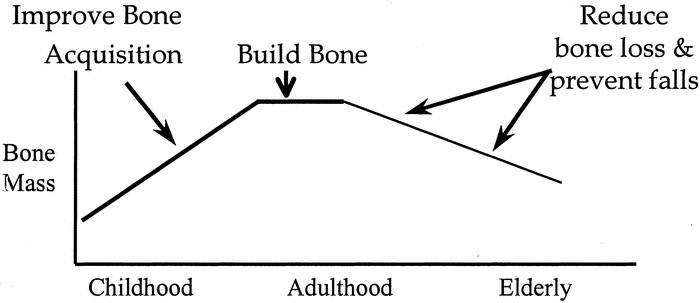
Types of exercise to consider.
One exercise method alone is not a significantly effective strategy to maintain strength, prevent bone loss, and reduce the risk of falling and fractures. There is a high degree of certainty of evidence that exercise programs involving balance, functional movement, and resistance training reduce the rate of falls and the number of persons experiencing falls.3 Muscular weakness, postural stability, and functional mobility are all important aspects of balance and risk factors for falls.4 Pilates offers a high complexity of exercise effects because it is weight-bearing and non-weight-bearing, dynamic resistance training, and aerobic and anaerobic. In addition, the fundamental principles of Pilates, like breath, control, and balanced muscle development, lay a strong foundation for exercises that build better balance.
Exercises for Better Balance
The Pilates method strengthens the core, improves balance, increases coordination, and decreases stress. Make it a part of your approach to maintaining overall health.
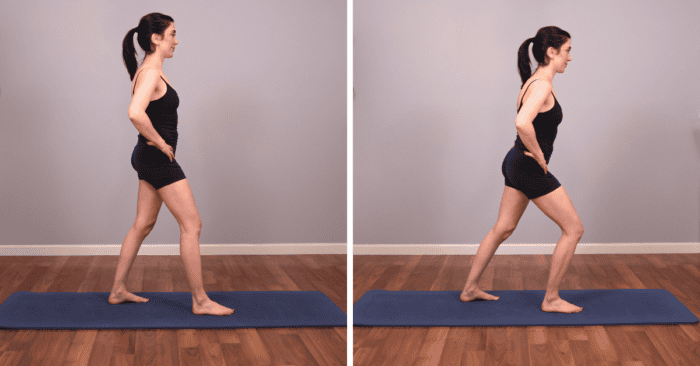
Forward Trunk Lunge
Lunging forward is different than falling forward. Work to keep your body upright, and you’ll feel more on an angle. Utilize the back leg just as much as the front.
- Step your feet forward and back like you are frozen mid-stride.
- Bend your front knee, shifting your center of gravity over the front foot while keeping your pelvis level and back heel down.
- Press into the forward heel, pulling your center of gravity back, and returning to neutral mid-stance. Repeat 8-10x.
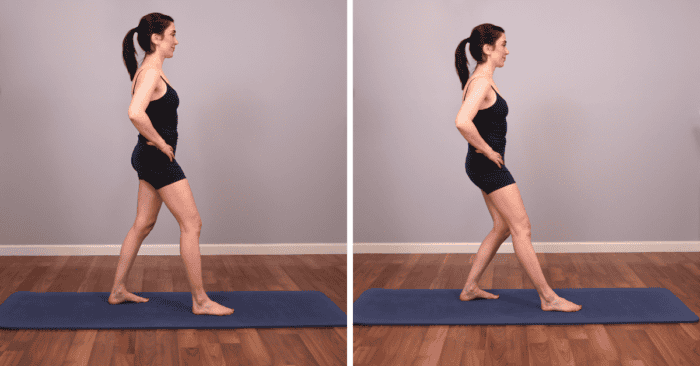
Backward Trunk Lean
A significant component of this exercise is the lengthening sensation in the bent knee’s quad, which aims to open that leg’s hip, knee, and ankle joints. If you don’t feel it, you may have moved from your pelvis versus keeping your spine neutral, shifting your center of gravity and stretching the quad.
- Step your feet forward and back like you are frozen mid-stride.
- Bend your back knee and bring your center of gravity back while keeping your pelvis level and your front foot down.
- Pressing into the back heel, serve your pelvis forward. Returning to neutral mid-stance. Repeat 8-10x.
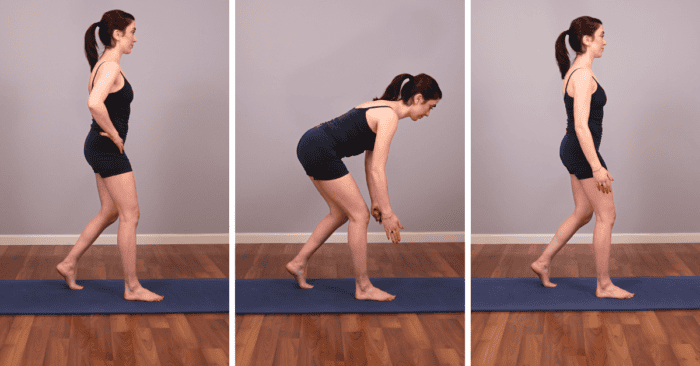
B-Stance Deadlift
Focus on pelvic positioning here and work through both legs. Understanding your Pilates neutral is a key component of this exercise.
- Stand mid-stride between front and back foot. Keep your center of gravity over both feet and lift your back heel.
- Hinge at the hips, keeping your head-ribcage-pelvis in line as you reach your arms to the ground.
- Pressing your pelvis forward, open your hips to lift back to tall standing. Do this anywhere between 8 and 10 times.
Practice the Foward and Backward Trunk Lean and the B-Stance Deadlift, then switch which leg is in front. Don’t be alarmed if the sides feel different.
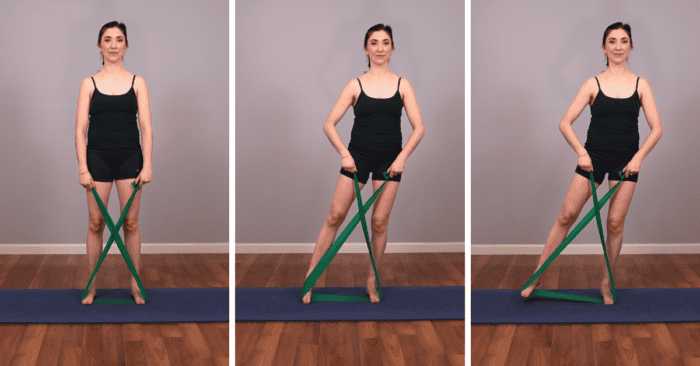
Standing Side Leg Lifts
A classic Pilates mat exercise, done upright, really challenges your balance. Keep this exercise small and adjust the resistance band’s tension to meet you where you’re at.
- Loop the resistance band around the bottoms of the feet, crossing it in front of the body and gathering the remaining length in your hands. You want the portion under your feet to be in tension, try to keep it even, left to right.
- Slightly shift your weight over one leg, pulling up through the leg and the hip, being careful not to collapse. Pressing the weightless foot into the resistance band, tap your toe to the mat.
- You can stay at step 2, or challenge your balance further and lift the weightless foot, pressing into the resistance band. Pulse. Do anywhere between 8 and 10. Repeat on the other side.

Crabwalk
This exercise builds the lateral hip, which helps keep our pelvis underneath us when we walk and supports our hips from dumping left/right.
- Pull against the resistance band to place the fists on the hip points for stability. Bend the knees to hover in a squat. Keep your center of gravity over the entire footbed. Be careful not to start to fall forward or round the spine into flexion.
- Step your inside foot out, pulling against the resistance band, but be careful not to upslip or downslip the pelvis or twist or move from the shoulders.
- Bring your outside foot in so that both feet are underneath you again. Continue to step across the mat one foot at a time. Go back and forth 8 to 10 reps.

Standing Row
Rowing helps strengthen the upper back and correct a forward-leaning posture. Ultimately helping to keep us upright.
- Loop the resistance band under the foot, cross at the front, and gather the remaining in your hands. Bend at the knees, put your hips back, and lift your heart up. Finding length in your spine.
- Reach the arms toward the floor, straightening them. Then bend and pull the fists to the hip points. Repeat 8-10 times.
Discover more step-by-step exercises for better balance.
The Take-Away for Better Balance
A body in motion stays in motion, and having a variety of movement methods helps keep your body moving dynamically and maintain balance in all planes of motion. The Pilates method connects and develops a deep understanding of movement into a flowing, whole-body experience. Integrating the mind, body, and spirit into exercises that create a life built on better balance!
Citations
- Kemmler, Wolfgang et al. “Effects of Different Types of Exercise on Bone Mineral Density in Postmenopausal Women: A Systematic Review and Meta-analysis.” Calcified tissue international vol. 107,5 (2020): 409-439. doi:10.1007/s00223-020-00744-w
- Beck, Belinda R.1; Snow, Christine M.2. Bone Health Across the Lifespan—Exercising Our Options. Exercise and Sport Sciences Reviews 31(3):p 117-122, July 2003.
- Sherrington, Catherine et al. “Exercise for preventing falls in older people living in the community.” The Cochrane database of systematic reviews vol. 1,1 CD012424. 31 Jan. 2019, doi:10.1002/14651858.CD012424.pub2
- Whipple, R H et al. “The relationship of knee and ankle weakness to falls in nursing home residents: an isokinetic study.” Journal of the American Geriatrics Society vol. 35,1 (1987): 13-20. doi:10.1111/j.1532-5415.1987.tb01313.x
Disclaimer:
THE INFORMATION EXPRESSED ON THIS SITE IS FOR EDUCATIONAL PURPOSES ONLY. WE DRAW ON OUR EXPERTISE AS PILATES AND MOVEMENT SPECIALISTS BY EXPANDING OUR PROFESSIONALISM THROUGH CONTINUING EDUCATION AND PERSONAL EXPERIENCES. WE AIM TO PROVIDE VALUABLE INFORMATION CONCERNING, BUT NOT LIMITED TO, PILATES, FUNCTIONAL MOVEMENT, AND FITNESS. YOU TAKE FULL RESPONSIBILITY FOR ALL DECISIONS NOW OR IN THE FUTURE CONCERNING YOUR HEALTH, LIFE, AND WELL-BEING. THIS INFORMATION IS NOT TO BE USED AS MEDICAL ADVICE EITHER TO DIAGNOSE, TREAT, CURE, OR PREVENT ANY DISEASE OR AILMENTS. YOU SHOULD CONSULT A PHYSICIAN BEFORE BEGINNING ANY EXERCISE PROGRAM.
